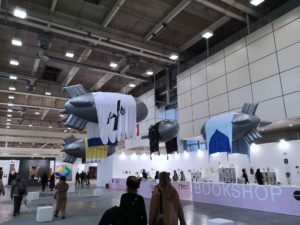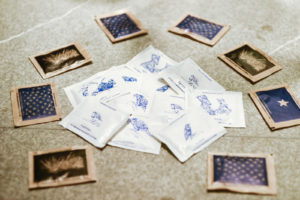 The 44th edition of the Bolognese art fair ARTE FIERA just closed. Time to reflect on this traditional trade show in the heart of the region Emilia-Romagna, Italy. Simone Menegoi, the artistic director for the second time, gathered 155 galleries, thereof 108 in the main section and 47 in the three sections with a special orientation. Altogether, there were 345 artists represented in the two halls, which were once again hosted in the pavilions 15 and 18, where the show took already place several years ago. The venue of the last years was directly accessible by the public transport. Nevertheless, every three to five minutes a shuttlebus departed from this point to the present entry. Overall, the event location was more spacious and with this less crowded, even though there were more visitors than last year, but the ways were a little bit longer.
The 44th edition of the Bolognese art fair ARTE FIERA just closed. Time to reflect on this traditional trade show in the heart of the region Emilia-Romagna, Italy. Simone Menegoi, the artistic director for the second time, gathered 155 galleries, thereof 108 in the main section and 47 in the three sections with a special orientation. Altogether, there were 345 artists represented in the two halls, which were once again hosted in the pavilions 15 and 18, where the show took already place several years ago. The venue of the last years was directly accessible by the public transport. Nevertheless, every three to five minutes a shuttlebus departed from this point to the present entry. Overall, the event location was more spacious and with this less crowded, even though there were more visitors than last year, but the ways were a little bit longer.
Within the main section, one part of the galleries focussed on the modern art of the 20th century, others concentrated on contemporary art of the present. Generally, this distinction was manifested by the spatial arrangement in the two halls, but not always. Eight exhibitors chosen for “Focus”, which represented artworks of the late 1950s until the late 1960s, were allocated in the two principal units.
Painting or non-painting?
After being welcomed by Eva Marisaldi’s four dirigible balloons (special project: Welcome) in the entrance hall, we passed through the 20th century art, not without looking here and there. Nevertheless, we concentrated on the contemporary art in the second hall, which started with the division of painting of the 21st century (19 galleries). Special attention attracted the booth of 1/9unosunove. The two represented artists expand the concept of painting: Jonathan Van Dyke uses dyed clothes to constitute mosaics like canvases. Included in this idea is that the resulting “painting” is not hanged at the wall but on a framework. This allows seeing the back, where other cut-outs form a different picture as at the front. Also Simon Callery’s “paintings” leave the two-dimensionality: out of monochrome pigmented canvas he creates all than plat artworks.
At the booth of P420 in the painting section, one was – at first glance – reminded to Matisse’s decoupages: colourful organic or geometric forms on light ground. However, in contrary to the French painter, Adelaide Cioni stitches her visually attracting compositions onto the canvas. In doing so, she adds tactile properties to the picture. Besides, also at the gallery’s stand in the main section, there were references to artistic ancestors: Paolo Icaro modified a metal grid recalling Vladimir Tatlin’s “Monument to the Third International”. At the same time, the sculpture called “Internet. Tatlin.” points to the digital age. Compared to Van Dyke, Callery and Cioni, the double booth of CAR DRDE and A + B showed classical painting. Both represented artists seem to depict familiar objects, even though both tend to abstraction. Markus Saile might paint spaces, landscapes or feelings. However, they all resist figurative assignment. Damien Meade creates images with a materiality, although the colours refuse to make a clear attribution to a special substance. Admittedly, also in the main section there were several paintings on view, some more classical, others beyond. Besides sculptural works, Flora Bigai brought Sergio Fermariello, who creates pictures on different supports. Remarkable are his delicate paintings with coloured paste of marble. All his images have in common that they depict warriors. However, in the miniature marble paste illustrations the model is not easy to discover. Photography as means to discover new worldsIn the section of “Photography and moving Images” (20 galleries) there was a variety range between poetic depiction and conceptual illustration. Rune Guneriussen at Marcorossi shows unexpected interventions in landscapes.
At Podbielsky Contemporary, the interventions in nature have another background. Massimiliano Gatti, Giulio di Struco and Yuval Yairi united around the theme of territory, have visited different countries to question about identity of space, considering inhabitation, design, exploitation and destruction by men. Therefore, they travelled the banks of Ganges, to the ancient city of Nineveh in Iraq or to the desert in Israel. Resulting are mostly silent photos, which invite to meditate. The Gallleriapiù extended the experimental photographs of Matteo Cremonesi by headrests, repeating the comforting forms of the artist’s black series. As counterpart stood white images of Cremonesi’s printer series, partly mounted like Ikea advertising. At the Galleria Martini & Ronchetti Lisetta Carmi was as solo show on view. Besides her photos taken in the harbour of Genoa in 1964, there was also the famous black and white series “I Travestiti”. This sequence was completed by unreleased coloured pictures of Cabiria, which underline the intimacy of their shooting. In the main section, Maria Livia Brunelli Home Gallery with Anna Di Prospero invited to sentimental journeys. Some carried us to a romantic promenade in the New York Central Park, others guided into the 17th century and the paintings of Carlo Bononi or into the Belle Époque of Giovanni Boldoni. Moreover, there were works from the so far unpublished series, dedicated to di Prospero’s recently born son and two works, which were realised site-specific for the Palazzo Ducale of Mantua, not to forget the quasi-iconic “Self-portrait with my mother” from 2011. Resting beyond the hustle and bustle To have a break, one might have stopped at one of the bars in the fair halls and would have taken a coffee with sugar. The offered sugar there and at other places in town was a special edition of sachet of sugar, with 40 different drawings made by Eva Marisaldi as part of her special project. Another possibility to find some rest beyond the hustle and bustle of the galleries booths was the exhibition “L’opera aperta” with works from public and private institutions of the region Emilia-Romagna. On view were some germs presented in a spacious area, so that the tired eyes could find some relaxation, to be fit for the next interesting galleries.
To have a break, one might have stopped at one of the bars in the fair halls and would have taken a coffee with sugar. The offered sugar there and at other places in town was a special edition of sachet of sugar, with 40 different drawings made by Eva Marisaldi as part of her special project. Another possibility to find some rest beyond the hustle and bustle of the galleries booths was the exhibition “L’opera aperta” with works from public and private institutions of the region Emilia-Romagna. On view were some germs presented in a spacious area, so that the tired eyes could find some relaxation, to be fit for the next interesting galleries.
Here some more impressions from the ARTE FIERA 2020:
Photography
Modern and Contemporary Art


















































































